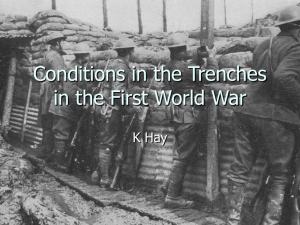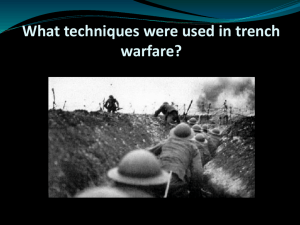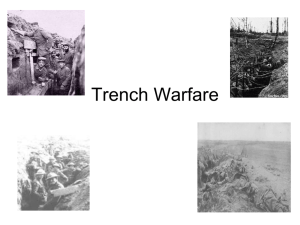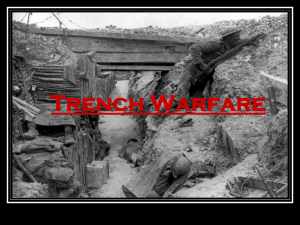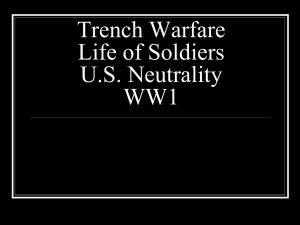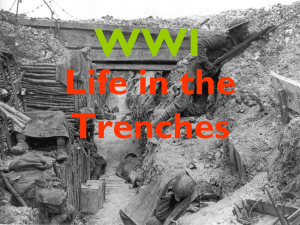trench system
advertisement
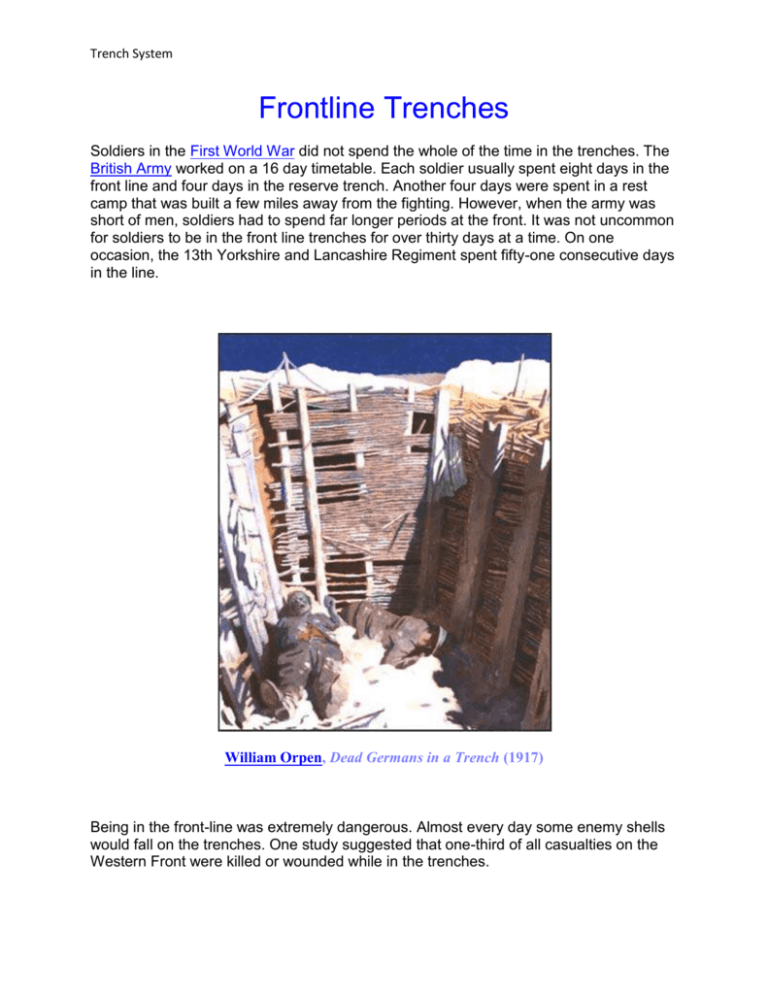
Trench System Frontline Trenches Soldiers in the First World War did not spend the whole of the time in the trenches. The British Army worked on a 16 day timetable. Each soldier usually spent eight days in the front line and four days in the reserve trench. Another four days were spent in a rest camp that was built a few miles away from the fighting. However, when the army was short of men, soldiers had to spend far longer periods at the front. It was not uncommon for soldiers to be in the front line trenches for over thirty days at a time. On one occasion, the 13th Yorkshire and Lancashire Regiment spent fifty-one consecutive days in the line. William Orpen, Dead Germans in a Trench (1917) Being in the front-line was extremely dangerous. Almost every day some enemy shells would fall on the trenches. One study suggested that one-third of all casualties on the Western Front were killed or wounded while in the trenches. Trench System Soldiers in the front line would also be hit by their own artillery. Despite the use of a high parados in the front-line trenches, it has been estimated that about 75,000 British soldiers in the war were killed by British shells that had been intended for the Germans. Communication Trenches The trench system on the Western Front consisted of front-line, support and reserve trenches. The three rows of trenches covered between 200 and 500 yards of ground. Communication trenches were dug at an angle to those facing the enemy. These trenches used to transport men, equipment and food supplies. The French tended to use tramways whereas Britain relied on their soldiers to carry supplies to forward positions. These carrying parties took supplies of water, food, ammunition, bombs and trench stores to the front-line. The communication trench was also used to transport wounded men to Casualty Clearing Station. Trench System French soldiers try to move a wounded man along a communication trench on the Western Front. Latrines The latrines was the name given to trench toilets. They were usually pits, 4 ft. to 5 ft. deep, dug at the end of a short sap. Each company had two sanitary personnel whose job it was to keep the latrines in good condition. In many units, officers gave out sanitary duty as a punishment for breaking army regulations. Before a change-over in the trenches, the out-going unit was supposed to fill in its latrines and dig a new one for the new arrivals. Dugouts Dugouts were protective holes dug out of the sides of trenches. The size of dugouts varied a great deal and sometimes could house over ten men. A manual published by the British Army recommended dugouts that were between 2 ft. and 4 ft. 6 in. wide, roofed with corrugated iron or brushwood and then covered with a minimum of 9 inches of earth. As the war went on dugouts grew in size. By 1917 dugouts at Messines could hold two battalions of soldiers at a time. Large dugouts were also built into the side of communication trenches so that they were not directly in line of fire from enemy guns. Trench System These often served as the battalion headquarters and provided sleeping accommodation for the officers. No Man's Land No Man's Land is the term used by soldiers to describe the ground between the two opposing trenches. Its width along the Western Front could vary a great deal. The average distance in most sectors was about 250 yards (230 metres). However, at Guillemont it was only 50 yards (46 metres) whereas at Cambrai it was over 500 yards (460 metres). The narrowest gap was at Zonnebeke where British and German soldiers were only about seven yards apart. No Man's Land contained a considerable amount of barbed wire. In the areas most likely to be attacked, there were ten belts of barbed wire just before the front-line trenches. In some places the wire was more than a 100 feet (30 metres) deep. No Man's Land at Passchendaele in 1917 If the area had seen a lot of action No Man's Land would be full of broken and abandoned military equipment. After an attack No Man's Land would also contain a large number of bodies. Advances across No Man's Land was always very difficult. Not Trench System only did the soldiers have to avoid being shot or blown-up, they also had to cope with barbed-wire and water-filled, shell-holes. Soldiers were only occasionally involved in a full-scale attack across No Man's Land. However, men were sometimes ordered into No Man's Land to obtain information about the enemy. When a artillery shell had landed just in front of an enemy trench, soldiers were often ordered to take control of the shell-hole and to try and spy on the enemy. C. R. W. Nevinson, Paths of Glory (1917) Small patrols were also sent out to obtain information about the enemy. These patrols would go out at night. They would have to crawl forward on their stomachs in an attempt to get close enough to find out what the enemy was up to. If possible, they would try and capture a sentry and bring him back for interrogation. To stop British night patrols the Germans used a light-shell rocket. Suspended from a small parachute, the flare blazed brightly for a minute giving the defending troops a chance to kill the soldiers who had advanced into No Man's Land. Barbed-Wire Entanglements Trenches on the Western Front were usually about seven feet deep and six feet wide. These trenches were protected by thick barbed-wire entanglements. Being a member of a wiring party was one of the most unpopular duties experienced by soldiers. This involved carrying out 6 ft. steel pickets and rolls of wire. The pickets were knocked into Trench System place by muffled mallets. When fastened to the pickets, the wire was pulled out to make what was known as a apron. Barbed-wire was usually placed far enough from the trenches to prevent the enemy from approaching close enough to lob grenades in. Sometimes barbed-wire entanglements were set up in order to channel attacking infantry into machine-gun fire. Drawings made by a allied spy of German barbed-wire Barbed-wire entanglements were virtually impassable. Before a major offensive soldiers were sent out to cut a path with wire-cutters. Another tactic was to place a Bangalore Torpedo (a long pipe filled with explosive) and detonate it under the wire. Heavy bombardment was necessary to destroy the barbed-wire. However, this always removed the crucial element of surprise. Many soldiers disputed the fact that shelling was capable of creating a gap in the wire. Arthur Coppard, who observed attempts to destroy barbed-wire entanglements at the Somme remarked: "Who told them that artillery fire would pound such wire to pieces, making it possible to get through? Any Tommy could have told them that shell fire lifts wire up and drops it down, often in a worse tangle than before." (1) Ernst Toller, I Was a German (1933) One night we heard a cry, the cry of one in excruciating pain; then all was quiet again. Trench System Someone in his death agony, we thought. But an hour later the cry came again. It never ceased the whole night. Nor the following night. Naked and inarticulate the cry persisted. We could not tell whether it came from the throat of German or Frenchman. It existed in its own right, an agonized indictment of heaven and earth. We thrust our fingers into our ears to stop its moan; but it was no good; the cry cut like a drill into our heads, dragging minutes into hours, hours into years. We withered and grew old between those cries. Later we learned that it was one of our own men hanging on the wire. Nobody could do anything for him; two men had already tried to save him, only to be shot themselves. We prayed desperately for his death. He took so long about it, and if he went on much longer we should go mad. But on the third day his cries were stopped by death.


